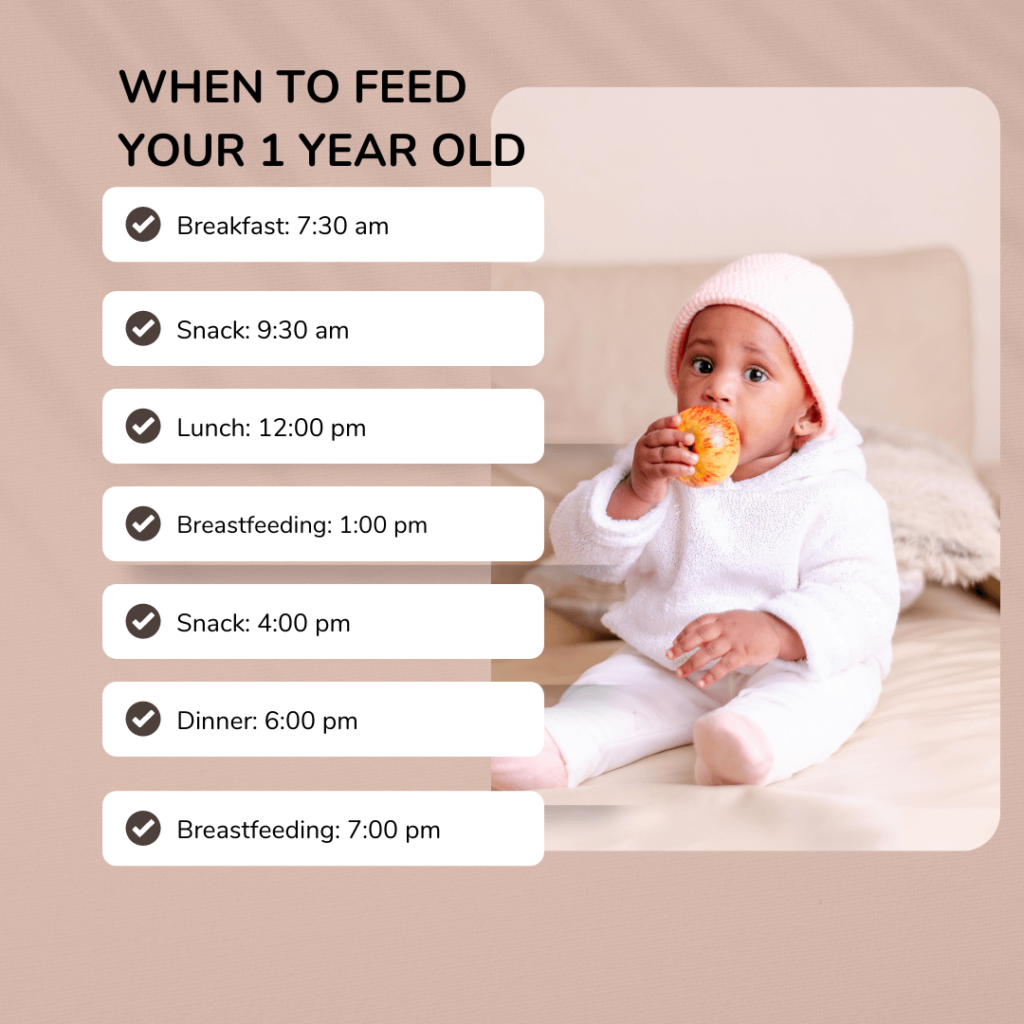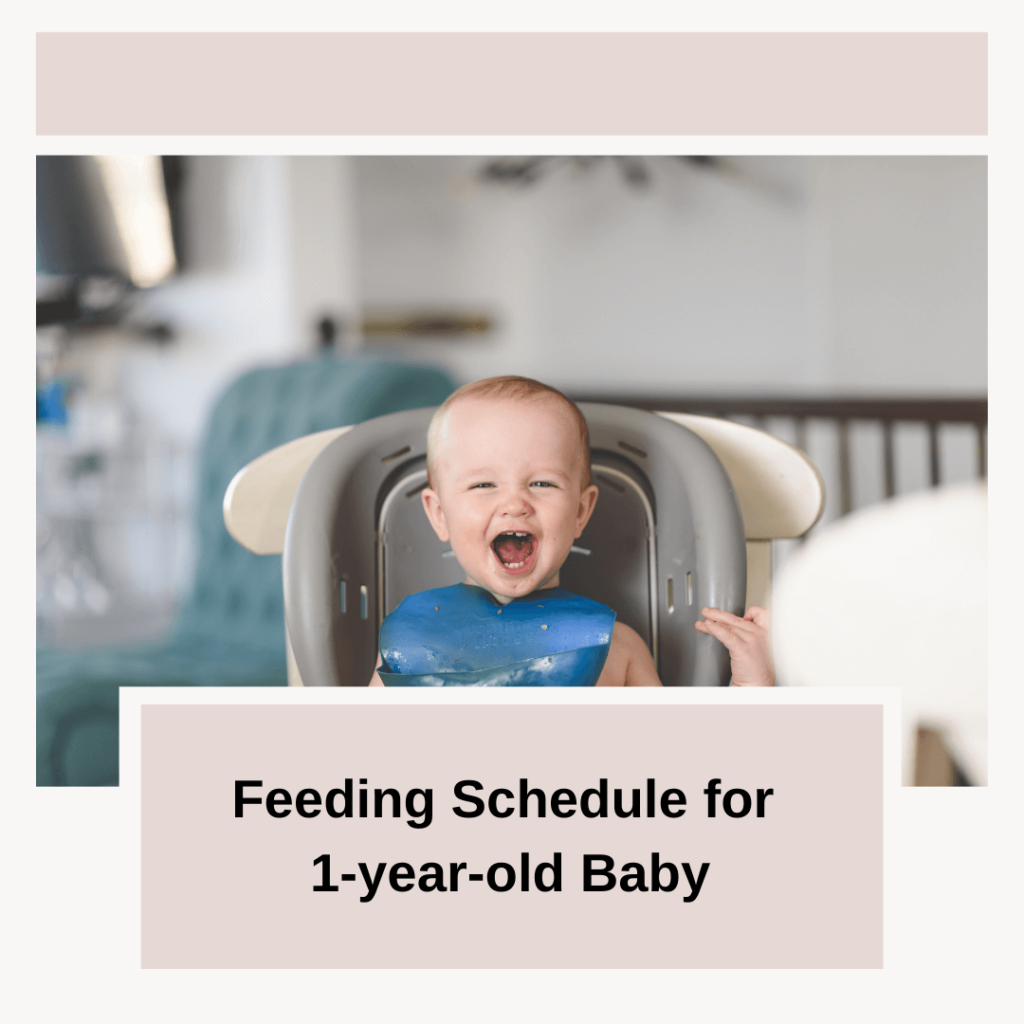Obviously, you are aware of the importance of eating well to maintain a strong and healthy body. Unfortunately, doing the same for babies can be a little more complicated because they don’t have the same preferences as us. To ensure your baby gets the most from every meal, you need an organized feeding schedule.
A 1-year-old baby’s feeding schedule will vary depending on their weight and appetite. Many parents are unsure about what to feed their children at this age. Here are some tips on creating a well-balanced and organized feeding schedule for your 1-year-old baby.
Table of Contents
One-Year-Old Feeding Schedule
When your child’s consumption of solids increases, you should also increase the frequency and size of their meals. Your 1-year-old baby will need to eat 4-6 times a day.
You may find that your baby is hungrier than usual during growth spurts. That is normal since rapid growth requires increased calorie intake. Growing children usually have a large appetite and can consume up to twice as many calories.
To help you plan balanced meals for your growing 1-year-old baby, we put together a sample menu that will keep them healthy and satisfied. This menu includes:
- Breakfast: 7:30 am
- Snack: 9:30 am
- Lunch : 12:00 pm
- Breastfeeding: 1:00 pm
- Snack: 4:00 pm
- Dinner: 6:00 pm
- Breastfeeding: 7:00 pm

Tip: You can skip the snacks if your baby is still satisfied with the breastmilk. Breast Milk is the perfect meal for babies, so be sure to feed them as often as needed.
Remember, all children are unique and will develop at their own pace. If your baby isn’t eating solid foods yet, don’t stress out. It’s entirely normal for them to wait until they’re around eight months old. Just make sure you offer nutritious meals that follow these guidelines. Ensure you consult with a doctor if there are any concerns regarding intake or digestion.
What Should You Feed Your Child at one year?
When your child turns one, you must start to introduce new foods into their diet. At this age, they can now chew and swallow solid food. New foods should be introduced slowly, though. This is because the digestive system of a 1-year old baby is not mature yet, and giving them too much at once may cause constipation.
You should feed the baby with small portions of:
- Milk
- Whole cereal
- Eggs
- Meat
- Legumes
- Fruits (except for citrus fruits)and
- Vegetables
Be sure to introduce new foods slowly but surely and monitor their bowel movements. If they start having difficulty going to the bathroom, it may indicate an allergy or intolerance towards certain foods. Keep an eye on skin reactions as well since many children are allergic to protein foods. Milk and eggs can be introduced at this age but should not replace breast milk or formula as a source of nourishment.
Foods to Avoid for a Year-Old Baby
As parents, our goal is to see our children grow healthy and strong, so naturally, we tend to give them the best foods available. But, of course, you can’t expect your baby to eat just any food, so it’s up to you to provide healthy choices.
That doesn’t mean that every choice has to be made for your child, though. They should have some control over their diet, so they learn proper eating habits early on. The problem comes in when one of those choices is something harmful or dangerous. Here are a few items you should avoid feeding your baby:
Foods to Avoid for a Year-Old Baby
As parents, our goal is to see our children grow healthy and strong, so naturally, we tend to give them the best foods available. But, of course, you can’t expect your baby to eat just any food, so it’s up to you to provide healthy choices.
That doesn’t mean that every choice has to be made for your child, though. They should have some control over their diet, so they learn proper eating habits early on. The problem comes in when one of those choices is something harmful or dangerous. Here are a few items you should avoid feeding your baby:
- Highly processed foods include factory-processed snacks like cookies, candy, Crips, cakes.
- Soft drinks and soda.
- Unpasteurized foods or raw dairy products, meat, and cider because they contain bacteria that can harm the child.
- High-mercury fish like shark, swordfish, king mackerel, tilefish, and fresh tuna contain high levels of mercury.
- Whole nuts and seeds because they can’t chew them yet.
How Much Food Should You Give a 1-year-old baby?
It is essential to understand that babies don’t eat the same amount of food as adults do. A baby’s meal plan should be much less generous than ours. Here are some essential feeding tips for infants:
- Around 4oz of milk in an open cup
- A fist-size serving of Carbohydrates and proteins
- One serving of fruits/veggies
- non-toxic feeding utensils
Each child’s appetite varies, but a fist-size serving is ideal. Consider the rule of thumb, if your baby seems hungry, offer them more food. They will let you know when they are full.
Measures to Take When Your Child Refuses to Eat Solid Foods
It is normal for a baby to go through the weaning process and reject solid foods at first. While some babies are more open to trying new things, others may take longer. Whatever their reaction might be, here are some tips if your child does not want to eat solids:
- Don’t insist or force them. Instead, try again later in the day or wait until the next meal time comes around. Just because they didn’t eat anything doesn’t mean they are hungry.
- If your baby does get hungry before it’s time for their next feeding, offer milk or formula. It will help decrease hunger pains while you continue with the weaning process.
- Mix your baby’s favorite food with what they don’t like just a little. Eventually, they’ll enjoy the new food.
- Be patient and listen to your child. If they are hungry, feed them. If they aren’t, don’t push it.
Mealtime Tips for a 1-Year-Old Baby
As your child makes their transition to solid foods, mealtime can become an inspiring and messy experience. Follow these tips as you get started:
- You may want to feed them a little less than usual for each meal since they will be eating more often now. The idea is to reduce their daily intake by 10 percent every couple of days until you reach the recommended amount. In general, babies should eat about 2-3 ounces per meal.
- Offer only one food at a time and mix it with milk or formula if they don’t seem interested. Give the baby about 5-10 minutes to take part before removing the food and trying again later.
- Make sure you sit down to feed them. Babies should never eat while standing up.
- If they make a mess, don’t get mad; use it as an opportunity to laugh together.
The most vital thing to consider when feeding your child is not how much he eats but rather what he eats. Make it a priority always to offer nutritious foods that contain lean meat, vegetables, dairy products, whole grains, and fruits.
Also, remember that healthy eating isn’t something that will happen overnight; it’s a process you’ll need to work on together with your child. The more consistent you are in providing good nutrition for them, the better.



